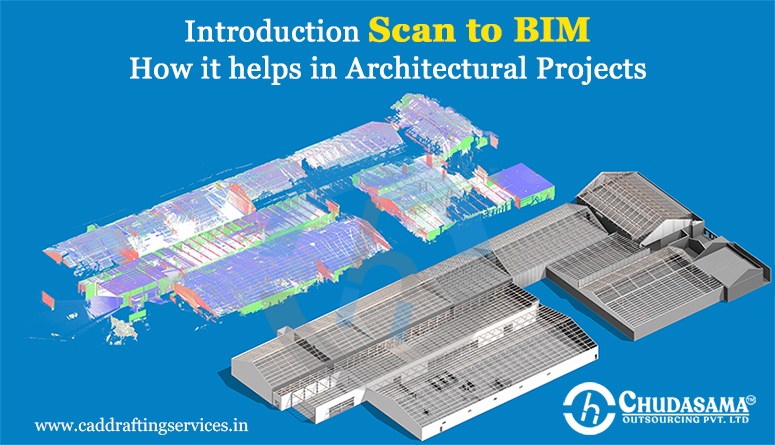Introduction Scan to BIM – How it helps in Architectural Projects
Architectural BIM Modeling Services

Building Information Modeling (BIM) is an important
and actually mandated method utilized globally to guarantee that
building construction, planning, and architecture are extraordinarily
efficient and unified. The AEC industry has continuously introduced new
strategies to boost productivity for years. One of these strategies is
to Scan to BIM Services. Laser Scan to BIM services is used for projects that require renovation. 3D BIM models are created using data obtained from laser scanning.
For renovation and reconstruction, Point Cloud to BIM
is frequently used to build As-Built Models. It facilitates the
development of a 3D BIM Model for infrastructures such as residential,
commercial, tunnels, airports, roads, factories, heritage buildings,
bridges, etc. These latest services are used for building projects by
architects, managers, general contractors, inspectors, and structural
engineers in the AEC sector.
The process of transforming point cloud data into a precise 3D model is known as Scan to BIM. We provide 3D BIM Modeling from LOD 100 to LOD 500 as part of our Point Cloud to 3D Modeling Services. We can assist you in developing accurate structural, architectural, and MEP BIM Models
that accurately represent the state of the building or plant as-built
using our extensive expertise and deep subject knowledge. Our BIM models
incorporate all building components, such as exterior landscape
features, MEP components, interior walls, pipes, columns, beams, and
ceilings.
We have completed Scan to 3D Modeling projects for numerous building types for years. Our skilled staff provides data-rich Scan to BIM Conversion
models that help stakeholders swiftly arrive at choices. By effectively
capturing and analyzing the 3D scan data, our skilled personnel is able
to exceed the client’s expectations. For restoration, refit, and
refurbishment projects, our BIM Conversion Services assists in the construction of as-built BIM Models.
Our Point Cloud to BIM Conversion Process
Our experts follow an easy and quick Point Cloud to BIM Conversion procedure, allowing you to observe the workflow at each stage. The following describes our Scan to BIM process:
- We extensively collaborate with the customer to ascertain their
needs, including the scope of work, anticipated turnaround time, and
other critical details.
- Data will be compiled by our survey experts utilizing BIM. If you
send us raw laser scans, we will gather the information for conversion.
- To make a 3D model that construction and engineering teams require,
we’ll use Revit. If necessary, further information would be uploaded to
BIM.
- The procedure will be examined by our project manager and quality
control team. We handle everything between scanning and model creation.
Our team will take an effort to provide accurate and compatible 3D
models.
Benefits of Outsourcing Scan to BIM Services
Outsourcing Scan to BIM Services to us can enable
you to concentrate on things that are more important as we remove the
need to engage a specialist Scan to BIM Conversion expert. You might
save lots of dollars a year just by doing this. Here are some more
advantages of using a Scan to BIM Modeling Service.
- Top-Quality Services: We frequently work with
clients who can’t tolerate even the smallest lapse in quality. As a
result, we make every effort to constantly provide top-notch Scan to BIM
Conversion services.
- Scalable Services: We provide scalable services. In
order to suit your needs in the shortest amount of time, our Point
Cloud to BIM services will be scaled up or down.
- Outstanding Infrastructure: Our infrastructure is
equipped with everything our team of Scan to BIM Conversion
professionals could possibly need. This made it possible for them to
provide top-notch services that adhere strictly to the criteria.
- Follow International Standards and Codes: We
provide Scan to BIM Services following international standards and
codes. We have made our approach open and transparent. Our BIM
Conversion Services always adhere to the rules and provide the most
value to your company.
- Security & Safety: We have staff that is aware
of how crucial the safety and security of data are. They have extensive
training in data safety security technology to protect your data from
management and access by unwanted parties. Our data management practices
adhere to the requirements of international standards.
- Better Turnaround Time: We excel in providing Scan
to BIM services in a short amount of time. Our trademark characteristic
is the timely delivery of 3D BIM models, and we work hard to maintain
this capacity.
- Cost-Effective: Because we offer solutions that
help you modify the services to your particular preferences, our
services are readily reasonable.
Conclusion
Many people, including engineers, contractors, designers, architects, builders, and owners, now use Scan to BIM Services.
Point Cloud Modeling has a variety of uses. For our clients, we create
3D BIM models from point cloud data that are very useful for 2D
documentation, clash detection, asset digitization, resource management,
etc.
We assist with the different demands of construction management
organizations, laser scanning businesses, general contractors, property
owners, MEP engineering companies, architectural design firms, and
surveyors among others, with our high-quality Scan to BIM Conversion Services.
For residential, commercial, educational, restaurants, and many more,
we are skilled in creating parametric 2D CAD models and 3D BIM that
capture architectural, structural, and MEP features.
To work with the stakeholders and make sure the building project goes
smoothly, we adhere to clear and flawless communication of each design
aspect. We oversee and manage the creation of BIM work with a
specialized team that makes sure of accuracy, and quality, and develops
the essential Architectural Services for every data-based model in order to ensure superior quality and workflow.
Source: https://caddraftingservices.in/blog/introduction-scan-to-bim-conversion/











652cc4a8bfcb2.jpg)
